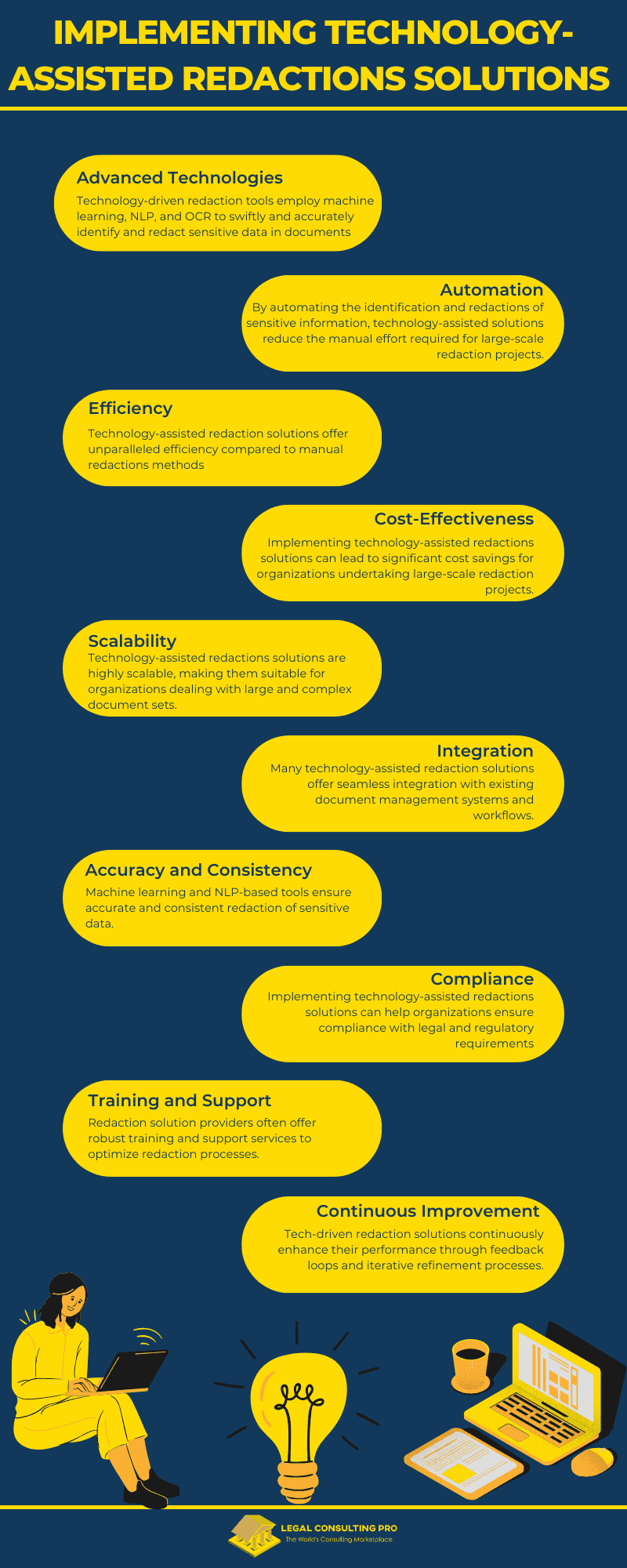In today’s digital age, the volume of electronically stored information (ESI) continues to grow exponentially, presenting new challenges for legal professionals tasked with managing and reviewing large-scale documents for litigation or regulatory compliance. Redaction of sensitive information from these documents is a critical step in protecting confidentiality and ensuring compliance with privacy regulations. However, the cost and complexity of conducting redaction reviews can pose significant challenges, particularly for organizations operating on a tight budget.
In this article, we explore cost-effective strategies and best practices for managing large-scale redaction reviews, leveraging litigation support services and innovative technologies to streamline the process and maximize efficiency.
Understanding the Scope of Redaction Reviews
Large-scale redaction projects encompass a vast array of documents, ranging from legal contracts and correspondence to financial records and sensitive personal information. These projects can involve thousands, if not millions, of documents that require meticulous review and redaction to ensure the protection of sensitive information. The sheer volume of documents involved in such projects makes manual review impractical, as it would be incredibly time-consuming and labor-intensive. Moreover, relying solely on manual methods increases the risk of human error, which can result in oversight or inconsistency in identifying and redacting sensitive information.
Furthermore, the complexity of large-scale redaction projects is compounded by the diverse formats and sources of the documents involved. These documents may be stored in various file formats, including PDFs, Word documents, spreadsheets, and emails, each requiring different tools and techniques for redaction. Additionally, the documents may originate from different sources, such as internal databases, third-party vendors, or cloud storage platforms, further complicating the review process.
Given these challenges, organizations undertaking large-scale redaction projects must seek efficient and accurate redaction solutions to streamline the process and mitigate risks. Leveraging advanced technologies and automation tools, such as machine learning algorithms and natural language processing (NLP) capabilities, can significantly enhance the efficiency and accuracy of redaction reviews. These technologies can automate the identification and redaction of sensitive information, reducing the burden on human reviewers and minimizing the risk of errors. Additionally, implementing robust quality assurance measures and oversight protocols is essential to ensure the integrity and accuracy of redacted documents throughout the review process.
By understanding the scope and complexity of large-scale redaction projects, organizations can implement cost-effective strategies and solutions to effectively manage these endeavors while safeguarding sensitive information and ensuring compliance with legal and regulatory requirements.
Utilizing Litigation Support Services
One cost-effective approach to managing large-scale redaction reviews is to utilize litigation support services. These services provide specialized expertise and resources to assist organizations in efficiently handling document review and redaction tasks. By outsourcing these tasks to experienced professionals, organizations can save time and resources while ensuring accurate and thorough redaction of sensitive information.
Litigation support services offer a range of benefits for managing redaction projects. These services typically employ trained professionals who are skilled in document review techniques and familiar with legal requirements for redaction. They also utilize advanced technologies and software tools designed specifically for document analysis and redaction, enabling faster and more accurate processing of large volumes of documents.
Moreover, litigation support services can scale resources based on project requirements, allowing organizations to adapt to fluctuations in workload without the need for extensive internal infrastructure or hiring additional staff. This flexibility is particularly valuable for organizations facing tight deadlines or variable project scopes.
Additionally, by outsourcing redaction tasks to litigation support services, organizations can benefit from a layer of quality control and oversight. These services often have established protocols and workflows for ensuring accuracy and consistency in redaction processes. They may also provide regular updates and reports on project progress, giving organizations transparency and confidence in the handling of sensitive information.
Furthermore, leveraging litigation support services can help organizations mitigate potential risks associated with redaction, such as inadvertent disclosures or errors. Experienced professionals can identify and redact sensitive information more effectively, reducing the likelihood of data breaches or compliance violations.
Key benefits of utilizing litigation support services for redaction reviews include:
- Expertise: Litigation support professionals possess extensive experience in document review and redaction, ensuring thorough and accurate identification of sensitive information.
- Scalability: Litigation support services can scale their resources to accommodate large volumes of documents, allowing for efficient processing and timely completion of redaction projects.
- Cost Savings: Outsourcing redaction reviews to litigation support services can be more cost-effective than hiring and training in-house staff, particularly for one-time or infrequent projects.
- Quality Assurance: Litigation support professionals follow rigorous quality assurance protocols to ensure that redactions are accurate and compliant with legal requirements, minimizing the risk of errors or oversights.
Implementing Technology-Assisted Redactions Solutions
- Advanced Technologies: Technology-assisted redaction solutions harness cutting-edge technologies like machine learning, natural language processing (NLP), and optical character recognition (OCR) to automate the identification and redactions of sensitive information within documents. These technologies enable organizations to significantly expedite the redaction process while maintaining accuracy and consistency.
- Automation: By automating the identification and redaction of sensitive information, technology-assisted solutions reduce the manual effort required for large-scale redaction projects. Machine learning algorithms can be trained to recognize patterns and keywords indicative of sensitive information, allowing for efficient and precise redactions across vast document repositories.
- Efficiency: Technology-assisted redaction solutions offer unparalleled efficiency compared to manual redactions methods. They can process large volumes of documents in a fraction of the time it would take human reviewers, enabling organizations to meet tight deadlines and manage redaction projects more effectively.
- Cost-Effectiveness: Implementing technology-assisted redactions solutions can lead to significant cost savings for organizations undertaking large-scale redaction projects. By reducing the need for manual labor and minimizing the risk of errors, these solutions offer a cost-effective alternative to traditional redaction methods.
- Scalability: Technology-assisted redactions solutions are highly scalable, making them suitable for organizations dealing with large and complex document sets. Whether processing thousands or millions of documents, these solutions can scale to meet the demands of the project without compromising efficiency or accuracy.
- Integration: Many technology-assisted redaction solutions offer seamless integration with existing document management systems and workflows. This integration allows organizations to incorporate redactions capabilities directly into their existing processes, streamlining the overall document review and redaction workflow.
- Accuracy and Consistency: By leveraging machine learning and NLP algorithms, technology-assisted redactions solutions ensure greater accuracy and consistency in identifying and redacting sensitive information. These solutions adhere to predefined rules and criteria, minimizing the risk of oversight or inconsistency in the redaction process.
- Compliance: Implementing technology-assisted redactions solutions can help organizations ensure compliance with legal and regulatory requirements governing the protection of sensitive information. By automating the redaction process and enforcing consistent redactions criteria, these solutions help organizations mitigate compliance risks and avoid potential penalties associated with data breaches or privacy violations.
- Training and Support: Many providers of technology-assisted redaction solutions offer comprehensive training and support services to help organizations maximize the effectiveness of their redaction efforts. These services may include user training, technical support, and ongoing updates to ensure that organizations can leverage the full capabilities of the solution.
- Continuous Improvement: Technology-assisted redaction solutions often incorporate feedback loops and iterative processes to continuously improve their performance over time. By analyzing user interactions and refining their algorithms, these solutions evolve to better meet the evolving needs and challenges of redactions projects, ensuring ongoing efficiency and effectiveness.

Key features and benefits of technology-assisted redactions solutions include:
- Automated Redaction: Machine learning algorithms can automatically detect and redact sensitive information, such as personally identifiable information (PII), financial data, or privileged content, within documents, reducing the need for manual review and intervention.
- Batch Processing: Technology-assisted redaction solutions can process large volumes of documents in batch mode, significantly reducing the time and resources required for redaction reviews.
- Accuracy and Consistency: By utilizing advanced algorithms and predefined rulesets, technology-assisted redaction solutions can ensure consistent and accurate redactions across all documents, minimizing the risk of errors or inconsistencies.
- Customization and Flexibility: Organizations can customize redaction rules and parameters to align with their specific requirements and preferences, allowing for greater flexibility and control over the redaction process.
Combining Litigation Support Services with Technology-Assisted Redactions
For organizations seeking the most cost-effective and efficient approach to managing large-scale redactions reviews, a combination of litigation support services and technology-assisted redaction solutions may offer the optimal solution. By leveraging the expertise of litigation support professionals and the capabilities of advanced redactions technologies, organizations can streamline the redaction process, reduce costs, and ensure compliance with legal and regulatory requirements.
Key considerations when combining litigation support services with technology-assisted redactions solutions include:
- Integration and Compatibility: Ensure that the chosen technology-assisted redaction solution integrates seamlessly with existing document management systems and workflows to maximize efficiency and minimize disruptions.
- Training and Support: Provide adequate training and support to litigation support professionals and staff members responsible for overseeing the redaction process, ensuring they are proficient in utilizing the selected redaction technologies effectively.
- Quality Assurance and Oversight: Establish robust quality assurance protocols and oversight mechanisms to monitor the accuracy and consistency of redactions performed by both litigation support professionals and technology-assisted redaction solutions.
- Cost-Benefit Analysis: Conduct a thorough cost-benefit analysis to evaluate the potential savings and efficiencies gained from outsourcing redaction tasks to litigation support services and implementing technology-assisted redaction solutions.
Conclusion
Managing large-scale redaction reviews on a budget requires careful planning, strategic utilization of resources, and leveraging innovative solutions such as litigation support services and technology-assisted redaction. By adopting a combination of these cost-effective strategies and best practices, organizations can streamline the redaction process, reduce costs, and ensure compliance with legal and regulatory requirements, ultimately achieving efficient and effective outcomes in their redaction efforts.
Similar Blogs:
Redactions & E-Discovery in the Digital Age: From Paper Trails to Pixels
Demystifying Redactions Processes for Clients and Stakeholders













































